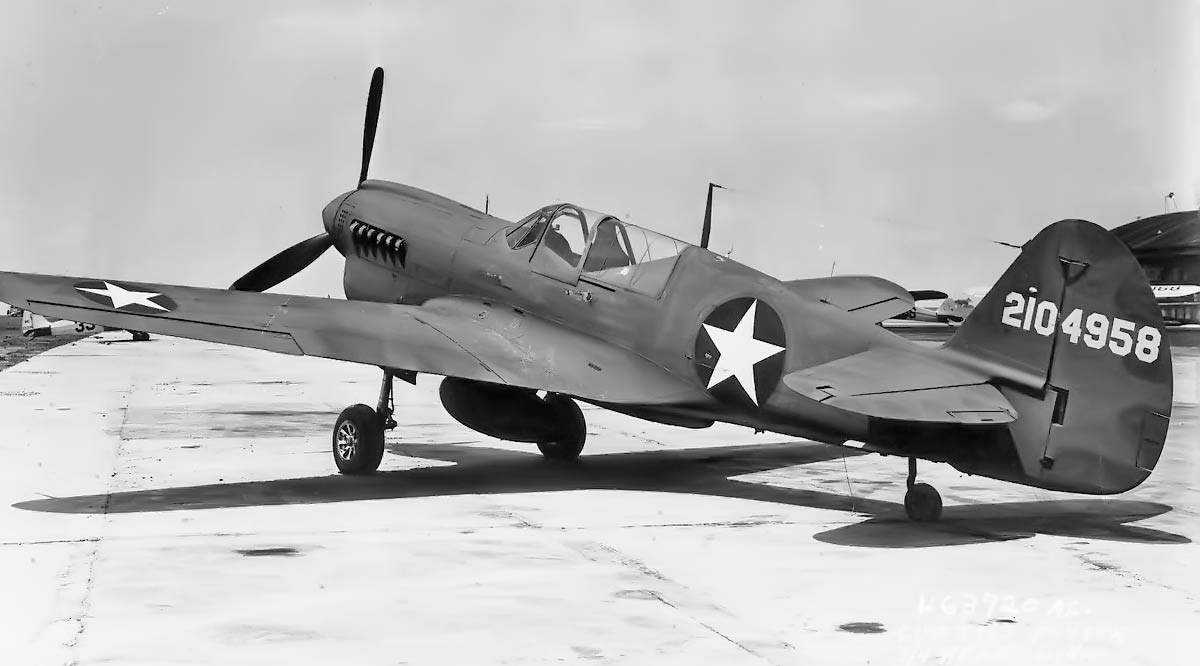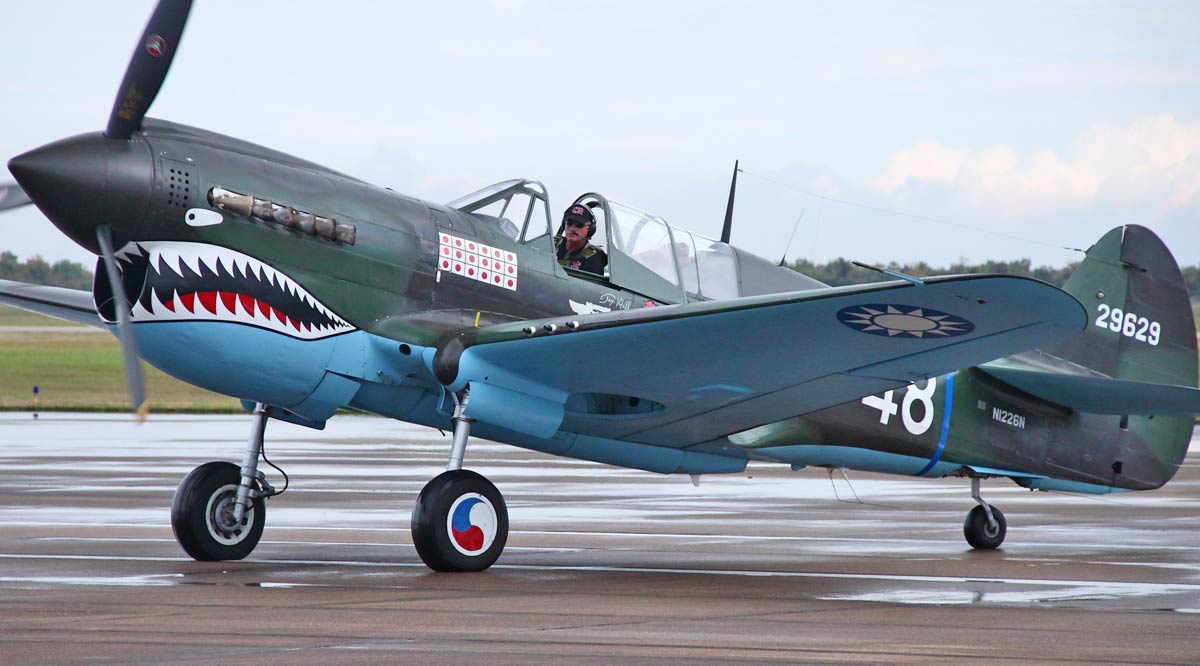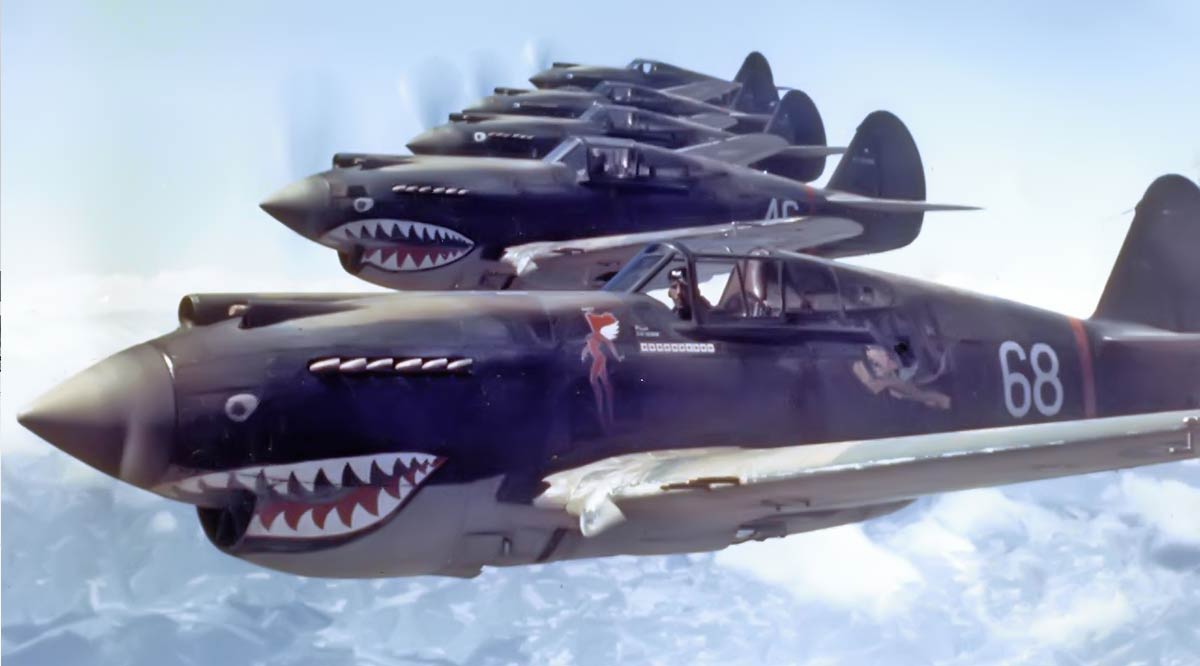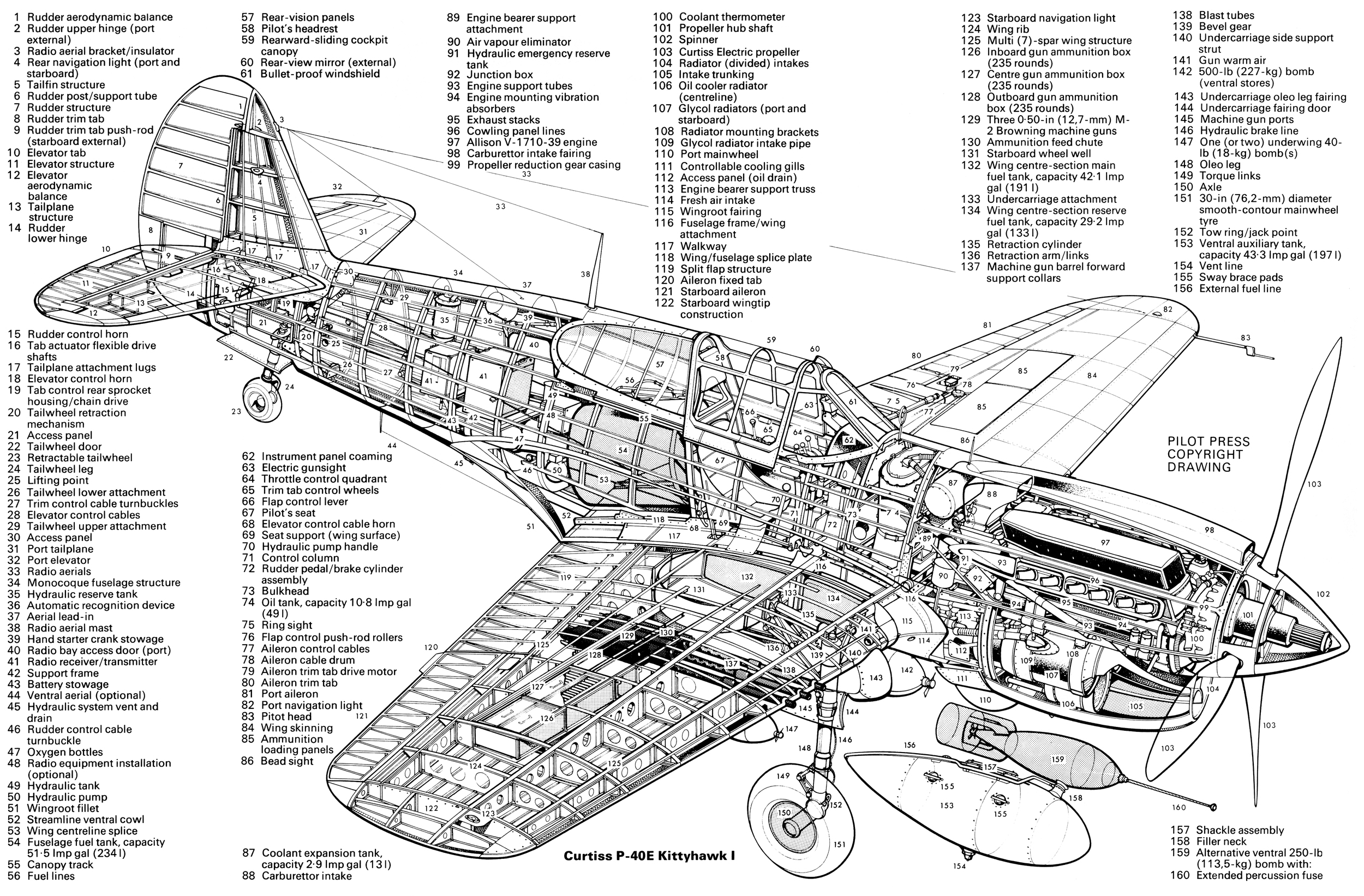Price: $34.95
- 10 magazines, 7 manuals, & photos
- PDF contains 1,310 pages
- Content is keyword searchable
- Print a personal copy
- Pay via PayPal or Credit Card
- International orders welcome!
- Download files upon payment
February 1973
- Hawkman, Exclusive Interview with Donovan Berlin, Designer of the P-36 and P-40
December 1974
- The Phantom P-40, Inside Story Of The Most Revamped, Yet Little Known Fighter Prototype Of All Time!
December 1975
- Desert Warriors, Flying the Curtiss Tomahawk and P-40 in Libya
October 1976
- Bicentennial Warhawk, Restoring One Of WW ll’s Most Popular Fighters
August 1979
- Hollywood’s Flying Tiger, Creating Legends In The Air And On The Sound Stage With General Robert Scott, Author Of “God Is My Co-pilot!”
March 1983
- Curtiss P-40, Last Of The Hawk’s Heritage, From P-36 To P-40
April 1983
- Heritage Of The Hawk, Pt. II Of The P-40 Story, Tomahawks & Kittyhawks Over The Western Desert, P-40s Over China And The Philippines
June 1998
- Evaluating The Most Significant Fighters Of WW II, From All The Warring Powers, Pt. I
May 1983
- Heritage Of The Hawk, Pt. III Of The P-40 Story, Merlin Engines And Laminar Flow Wings Fail To Keep Curtiss In The Fighter Business!
December 2001
- Lost & Leaderless, The Doomed P-40s of the 57th Pursuit Group
Manuals & Photos
- P-40 Flight Manual
- P-40 Pilot Training Manual, 1943
- P-40 Pilot’s Manual
- P-40D/E Operations Handbook, 1941
- P-40N British Flight Manual, 1944
- P-40 Armament, Hydraulic & Fuselage Tank Service Instructions, 1942
- P-40 Erection and Maintance, 1944
- Over 460 photos of the P-40 Warhawk
Curtiss P-40 Warhawk
P-40E Specifications
Variants
Comparison
On Display
Cutaway
General Characteristics

- Crew: 1
- Length: 31.67 ft (9.66 m)
- Wingspan: 37.33 ft (11.38 m)
- Height: 12.33 ft (3.76 m)
- Wing area: 235.94 ft² (21.92 m²)
- Airfoil: NACA2215 / NACA2209
- Empty weight: 6,070 lb (2,753 kg)
- Loaded weight: 8,280 lb (3,760 kg)
- Max. takeoff weight: 8,810 lb (4,000 kg)
- Powerplant: 1 × Allison V-1710-39 liquid-cooled V12 engine, 1,150 hp (858 kW)
Performance
- Maximum speed: 360 mph (310 kn, 580 km/h)
- Cruise speed: 270 mph (235 kn, 435 km/h)
- Range: 650 mi (560 nmi, 1,100 km)
- Service ceiling: 29,000 ft (8,800 m)
- Rate of climb: 2,100 ft/min (11 m/s)
- Wing loading: 35.1 lb/ft² (171.5 kg/m²)
- Power/mass: 0.14 hp/lb (228 W/kg)
Armament
- Guns: 6 × .50 in (12.7 mm) M2 Browning machine guns with 235 rounds per gun in the wings
- Bombs: 250 to 1,000 lb (110 to 450 kg) bombs to a total of 2,000 lb (907 kg) on three hardpoints (one under the fuselage and two underwing)
- The original Curtiss XP-40, ordered July 1937, was converted from the 10th P-36A by replacing the radial engine with a new Allison V-1710-19 engine. It flew for the first time in October 1938. This new liquid-cooled engine fighter had a radiator mounted under the rear fuselage but the prototype XP-40 was later modified and the radiator was moved forward under the engine.
- The P-40 (Curtiss Model 81A-1) was the first production variant, 199 built.
- One P-40 was modified with a camera installation in the rear fuselage and re-designated P-40A.
- P-40B : Revised versions of the P-40 soon followed: the P-40B or Tomahawk IIA had extra .30 in (7.62 mm) U.S., or .303 in (7.7 mm) machine guns in the wings and a partially protected fuel system;
- P-40C or Tomahawk IIB added underbelly drop tank and bomb shackles, self-sealing fuel tanks and other minor revisions, but the extra weight did have a negative impact on aircraft performance. (All versions of the P-40 had a relatively low power-to-weight ratio compared to contemporary fighters.)
- Only a small number of P-40D or Kittyhawk Mk Is were made, less than 50. With a new, larger Allison engine, slightly narrower fuselage, redesigned canopy, and improved cockpit, the P-40D eliminated the nose-mounted .50 in (12.7 mm) guns and instead had a pair of .50 in (12.7 mm) guns in each wing. The distinctive chin airscoop grew larger so they could adequately cool the large Allison engine.
- The P-40E or P-40E-1 was similar in most respects to the P-40D, except for a slightly more powerful engine and an extra .50 in (12.7 mm) gun in each wing, bringing the total to six. Some aircraft also had small underwing bomb shackles. Supplied to the Commonwealth air forces as the Kittyhawk Mk IA. The P-40E was the variant that bore the brunt of air-to-air combat by the type in the key period of early to mid 1942, for example with the first US squadrons to replace the AVG in China (the AVG was already transitioning to this type from the P-40B/C), the type used by the Australians at Milne Bay, by the New Zealand squadrons during most of their air-to-air combat, and by the RAF/Commonwealth in North Africa as the Kittyhawk IA.
- P-40F and P-40L, which both featured Packard V-1650 Merlin engine in place of the normal Allison, and thus did not have the carburetor scoop on top of the nose. Performance for these models at higher altitudes was better than their Allison-engined cousins. The L in some cases also featured a fillet in front of the vertical stabilizer, or a stretched fuselage to compensate for the higher torque. The P-40L was sometimes nicknamed “Gypsy Rose Lee”, after a famous stripper of the era, due to its stripped-down condition. Supplied to the Commonwealth air forces under the designation Kittyhawk Mk II, a total of 330 Mk IIs were supplied to the RAF under Lend-Lease. The first 230 aircraft are sometimes known as the Kittyhawk Mk IIA. The P-40F/L was extensively used by U.S. fighter groups operating in the Mediterranean Theater.
- P-40G : 43 P-40 aircraft fitted with the wings of the Tomahawk Mk IIA. A total of 16 aircraft were supplied to the Soviet Union, and the rest to the US Army Air Forces. It was later redesignated RP-40G.
- P-40K, an Allison-engined P-40L, with the nose-top scoop retained and the Allison-configured nose radiators scoop, cowl flaps and vertical-stabilizer-to-fuselage fillet. Supplied to the Commonwealth air forces as the Kittyhawk Mk III, it was widely used by US units in the CBI.
- P-40M, version generally similar to the P-40K, with a stretched fuselage like the P-40L and powered by an Allison V-1710-81 engine giving better performance at altitude (compared to previous Allison versions). It had some detail improvements and it was characterized by two small air scoops just before the exhaust pipes. Most of them were supplied to Allied countries (mainly UK and USSR), while some others remained in the USA for advanced training. It was also supplied to the Commonwealth air forces as the Kittyhawk Mk. III.
- P-40N (manufactured 1943–44), the final production model. The P-40N featured a stretched rear fuselage to counter the torque of the larger, late-war Allison engine, and the rear deck of the cockpit behind the pilot was cut down at a moderate slant to improve rearward visibility. A great deal of work was also done to try and eliminate excess weight to improve the Warhawk’s climb rate. Early N production blocks dropped a .50 in (12.7 mm) gun from each wing, bringing the total back to four; later production blocks reintroduced it after complaints from units in the field. Supplied to Commonwealth air forces as the Kittyhawk Mk IV. A total of 553 P-40Ns were acquired by the Royal Australian Air Force, making it the variant most commonly used by the RAAF. Subvariants of the P-40N ranged widely in specialization from stripped down four-gun “hot rods” that could reach the highest top speeds of any production variant of the P-40 (up to 380 mph), to overweight types with all the extras intended for fighter-bombing or even training missions. The 15,000th P-40 was an N model decorated with the markings of 28 nations that had employed any of Curtiss-Wright’s various aircraft products, not just P-40s. “These spectacular markings gave rise to the erroneous belief that the P-40 series had been used by all 28 countries.” Survivors redesignated as ZF-40N in June 1948.
- P-40P : The designation of 1,500 aircraft ordered with V-1650-1 engines, but actually built as the P-40N with V-1710-81 engines.
- XP-40Q with a 4-bladed prop, cut-down rear fuselage and bubble canopy, supercharger, squared-off wingtips and tail surfaces, and improved engine with two-speed supercharger was tested, but its performance was not enough of an improvement to merit production when compared to the contemporary late model P-47Ds and P-51Ds pouring off production lines. The XP-40Q was, however, the fastest of the P-40 series with a top speed of 422 mph (679 km/h) as a result of the introduction of a high-altitude supercharger gear. (No P-40 model with a single-speed supercharger could even approach 400 mph (640 km/h)) With the end of hostilities in Europe, the P-40 came to the end of its front line service.
- P-40R : The designation of P-40F and P-40L aircraft, converted into training aircraft in 1944.
- RP-40 : Some American P-40s were converted into reconnaissance aircraft.
- TP-40 : Some P-40s were converted into two-seat trainers.
- Twin P-40 : Probably the most unusual variant, it was a P-40C outfitted in 1942 with a pair of 1,300 hp (969 kW) Packard V-1650-1 Merlin engines mounted atop the wings, over the main landing gear.
A listing of specifications for major P-40 variants.
| P-40B | P-40E | P-40F | P-40N | |
|---|---|---|---|---|
| Crew | One | One | One | One |
| Length | 31 ft 8 in (9.66 m) | 31 ft 8 in (9.66 m) | 31 feet 2 in, from P-40F-5-CU 33 feet 4 in (11,38 m) | 33 ft 4 in (10.16 m) |
| Wingspan | 37 ft 4 in (11.38 m) | 37 ft 4 in (11.38 m) | 37 ft 4 in (11.38 m) | 37 ft 4 in (11.38 m) |
| Height | 12 ft 4 in (3.76 m) | 12 ft 4 in (3.76 m) | 12 ft 4 in (3.76 m) | 12 ft 4 in (3.76 m) |
| Wing area | 235.94 ft² (21.92 m²) | 235.94 ft² (21.92 m²) | 235.94 ft² (21.92 m²) | 235.94 ft² (21.92 m²) |
| Empty weight | 5,590 lb (2,535 kg) | 6,350 lb (2,880 kg) | 6,590 lb (2,990 kg) | 6,405 lb (2,905 kg) |
| Loaded weight | 7,326 lb (3,323 kg) | 8,280 lb (3,760 kg) | 8,500 lb (3,855 kg) | 7,730 lb (3,505 kg) |
| Maximum gross takeoff weight | 7,600 lb (3,447 kg) | 8,810 lb (4,000 kg) | 9,350 lb (4,238 kg) | 8,860 lb (4,020 kg) |
| Powerplant | 1x Allison V-1710-33, 1,040 hp | 1x Allison V-1710-39, 1,150 hp (860 kW) | 1x Packard V-1650-1, 1,300 hp | 1x Allison V-1710-81, 1,200 hp (895 kW)Late-series P-40N-40 had V-1710-115, 1,360 hp (1,015 kW) |
| P-40B | P-40E | P-40F | P-40N | |
| Maximum speed | 352 mph (566 km/h) | 360 mph (580 km/h) | 364 mph at 20,000 ft (585 km/h) | 378 mph (608 km/h) at 5,000 m (16,400 ft)(light version) |
| Cruise speed | n.a. | 270 mph (435 km/h) | n.a. | 280 mph (455 km/h) |
| Range | 730-1230 mi (1,173-1,977 km) | 650 mi (1,050 km) | 700-1500 mi with 141.5 Imp gal drop tank (1k125-2,400 km) | 745 mi (1,200 km) |
| Service ceiling | 32,400 ft (9,875 m) | 29,000 ft (8,840 m) | 34,400 ft (10,500 m) | 31,000 ft (9,450 m) |
| Climb rate | 2,860 ft/min (14.5 m/s) | 2,100 ft/min (10.7 m/s) | to 6,100 m in 11,6 min | 2,240 ft/min (11.4 m/s) |
| Wing loading | 152.3 kg/m² | 35.1 lb/ft² (171.5 kg/m²) | 176 kg/m² | 32.8 lb/ft² (159.9 kg/m²) |
| Power/mass | 0.16 hp/lb | 0.14 hp/lb (230 W/kg) | 0.15 hp/lb | 0.16 hp/lb (260 W/kg) |
| P-40B | P-40E | P-40F | P-40N | |
| Armament | 2×12.7 mm and 4x 0.30-inch Browning | 6x .50 cal (12.7 mm) Browning M2 machine guns, 281 rounds/gunUp to 1,500 lb (680 kg) of bombs on three hardpoints. | 4 or 6 M2, 240-312 rounds/gun2x227 kg bomb | 4x .50 cal (12.7 mm) Browning M2 machine gunsUp to 1,500 lb (680 kg) of bombs on three hardpoints. |
Australia
- Airworthy
-
- P-40E
- 41-25109/VH-KTY – owned by Pay’s Air Service PTY LTD in Scone, New South Wales. Was NZ3094 with the RNZAF.
-
- P-40F
- 41-14112/VH-HWK – owned by Judy Pay in Tyabb, Victoria.
-
- P-40N
- 42-104687/VH-ZOC – owned by Arthur Pipe & Steel Australia PTY LTD in East Albury, New South Wales. Was NZ3125 in RNZAF service.
- 42-104977/VH-MIK – owned by Cairns Airport Hangars PTY LTD in Cairns, Queensland.
- On display
-
- P-40E
- 41-36084 – Australian War Memorial in Canberra.
-
- P-40N
- 42-104947 – Precision Aerospace/Pacific Fighters Museum in Victoria, Australia.
- Under restoration
-
- P-40E
- 41-35974/VH-AJY – owned by Reevers Pastoral PTY LTD in Mylor, South Australia.
- 41-5336 – RAAF Museum in RAAF Point Cook, Victoria.
- 41-5632 – under restoration by Ben Saunders in Melbourne, Victoria.
- 41-13522 – under restoration by Moorabbin Air Museum in Melbourne, Victoria.
- 41-35984 – under restoration by P-40E Syndicate in Queensland.
- 41-36843 – under restoration by Murray Griffiths in Deniliquin, New South Wales.
-
- P-40N
- 42-104954 – under restoration by Edwin Sedgman in Melbourne, Victoria.
- 42-105051 – under restoration by Keith W. Hopper in Townsville, Queensland.
- 42-105472 – under restoration by Bruno Carnival in Melbourne, Victoria.
- 42-105513 – under restoration by Australian Aerospace Museum in Melbourne, Victoria.
Brazil
- P-40N
- 44-7700 – Museum Aerospacial, Rio de Janeiro.
Canada
- Airworthy
-
- P-40N
- 42-104827 – Vintage Wings of Canada in Ottawa.
- On display
-
- P-40E
- AL135 – Canada Aviation Museum in Ottawa.
- AK803 – Victoria International Airport in British Columbia.
Egypt
- P-40
- ET574 – was recently found in the desert and is fairly well-preserved. The Royal Air Force Museum in London, England expects to recover the aircraft and return it to the U.K.
France
- Airworthy
-
- P-40N
- 42-105915 – Christian Amara/SDPA in La Ferté-Alais.
- Wrecks
- s/n unknown – A fairly complete wreck of a P-40 is immersed in 18 feet of water near the semi-decommissioned French fleet air arm station of Aspretto, Ajaccio, Corsica. It was found in much deeper waters by military divers and moved in present time location for training purposes. It is theoretically off limits but has been much dived in the past 30 years, images and video footage are visible on internet.
Italy
- P-40L
- 42-10857 – on display in its recovered condition at the Piana delle Orme near Latina, Lazio.
New Zealand
- Airworthy
-
- P-40E
- 41-25158/NZ3009 – Old Stick and Rudder Company in Masterton as ZK-RMH.
-
- P-40N
- 42-104730/A29-448 – Warbird Adventure Rides Ltd in Auckland as ZK-CAG.
- On display
-
- P-40E
- 41-36385/NZ3039 – Museum of Transport and Technology in Auckland.
-
- P-40F
- 41-14205 – restored to E-model status and on display at the RNZAF Museum.
- Stored
-
- P-40E
- 41-36410/NZ3043 – stored by John R. Smith in Nelson, NZ.
-
- P-40K
- 42-10178/A29-183 – stored pending restoration by Graham Orphan in Blenheim.
-
- P-40N
- 42-104818/A29-405 – stored pending restoration by Graham Orphan in Blenheim.
- 43-22962/NZ3220 – stored by John R. Smith in Nelson, NZ.
Russia
- P-40C
- s/n unknown – TsAGI in Moscow.
Thailand
- P-40C
- AK498 – on display as a crashed diorama at the Royal Thai Air Force Museum.
United Kingdom
- Airworthy
-
- P-40C
- 41-13357 – The Fighter Collection at IWM Duxford.
-
- P-40F
- 41-19841 – The Fighter Collection at IWM Duxford.
-
- P-40M
- 43-5802 – Hangar 11 Collection in North Weald, Essex.
- On display
-
- P-40N
- 42-106101/A29-556 – Royal Air Force Museum London.
United States
- Airworthy
-
- P-40B
- 41-13297 – Collings Foundation in Stow, Massachusetts.
-
- P-40C/Tomahawk IIB
- 41-13390 – Flying Heritage Collection in Everett, Washington.
- AK295 – Lewis Air Legends in San Antonio, Texas.
-
- P-40E/Kittyhawk IA
- AK752 – Stonehenge Air Museum in Lincoln County, Montana.
- AK753 – Fagen Fighters WWII Museum in Granite Falls, Minnesota.
- AK827 – Yanks Air Museum in Chino, California.
- AK905 – Frasca Air Museum in Champaign, Illinois.
- AK933 – Warhawk Air Museum in Boise, Idaho.
- AK940 – Banta Aviation Corp. in Dover, Delaware.
- AL152 – War Eagles Air Museum in Santa Teresa, New Mexico.
- ET573 – Military Aviation Museum in Virginia Beach, Virginia.
-
- P-40K
- 42-9733 – Claire Aviation Inc. in Wilmington, Delaware.
- 42-10083 – Fagen’s Fighters WWII Museum in Granite Falls, Minnesota.
- 42-10256 Aleutian Tiger – Texas Flying Legends Museum in Houston, Texas.
-
- P-40M
- 43-5795 The Jackie C II – American Airpower Museum in Farmingdale, New York.
- 43-5813/NZ3119 – Tri-State Warbird Museum in Batavia, Ohio.
-
- P-40N
- 42-104959 – Legacy Aviation Partners LLC in Wilmington, Delaware.
- 42-105192 – Planes of Fame in Chino, California.
- 42-105306 – Hawks Zero Q3 LLC in Sonoma, California.
- 42-105861 – Chuzy Suzy LCC in Lafayette, Louisiana.
- 42-105867 – Commemorative Air Force (P-40 Sponsor Group) in Fredericksburg, Texas.
- 42-106396 – Warhawk Air Museum in Boise, Idaho.
- 44-7084 – Palm Springs Air Museum in Palm Springs, California.
- 44-7369 – Cavanaugh Flight Museum in Addison, Texas.
- 44-7983 – Skyfire Corp. in Wilmington, Delaware.
-
- TP-40N
- 44-47923 – Fantasy of Flight in Polk City, Florida.
- On display
-
- P-40C/Tomahawk IIB
- AK255 – National Naval Aviation Museum at NAS Pensacola in Florida.
-
- P-40E/Kittyhawk IA
- AK875 – Steven F. Udvar-Hazy Center of the National Air and Space Museum in Chantilly, Virginia.
- AK979 – Pacific Aviation Museum Pearl Harbor on Ford Island in Pearl Harbor, Hawaii.
- AK987 – National Museum of the United States Air Force at Wright-Patterson AFB in Dayton, Ohio.
-
- P-40K
- 42-9749 – Evergreen Aviation & Space Museum in McMinnville, Oregon.
-
- P-40N
- 42-105270 – Hill Aerospace Museum at Hill AFB in Utah. This aircraft is actually a composite of a P-40E fiberglass replica and a wrecked P-40N recovered from Alaska. The dataplates were unreadable so the Hill Aerospace Museum chose the serial number of a scrapped P-40 that had been flown by the same squadron that the wrecked aircraft belonged to.
- 42-105927 – Museum of Aviation at Robins AFB in Warner Robins, Georgia.
- 44-7192 – Museum of Flight in Seattle, Washington.
- 44-7619 – Air Zoo in Kalamazoo, Michigan.
- Under restoration or in storage
-
- P-40E/Kittyhawk IA
- 40-401 – to airworthiness by Christopher Provost in Sonoma, California.
- AK863 – in storage at Fagen’s Fighters WWII Museum in Granite Falls, Minnesota.
- AL171 – in storage at Fantasy of Flight in Polk City, Florida.
-
- P-40K
- 42-45946 – to airworthiness by Dwight Jones in Anchorage, Alaska.
- 42-45984 – for static display at the Pima Air & Space Museum adjacent to Davis-Monthan Air Force Base in Tucson, Arizona. Crashed in 1942 in New Guinea, it was recovered in 2000 and donated to the Pima Air & Space Museum in 2002.
-
- P-40N
- s/n unknown – to airworthiness by C&G Air in Wilmington, Delaware.
- 42-104949 Kathleen II – to airworthiness by Mickael Rabilloud in Framingham, Massachusetts. Flown by the comedian Dan Rowan in World War II.
- 42-104961 – for static display at the Pima Air & Space Museum adjacent to Davis-Monthan Air Force Base in Tucson, Arizona. Crashed in 1943 in New Guinea, it was recovered in 1974 by the Military Aircraft Restoration Corporation and loaned to the Pima Air & Space Museum in 2004.
- 42-105526 – to airworthiness by Craig Schultz in Santa Rosa, California.
Replicas
- P-40 mounted on plinth at entrance to the March Field Air Museum, March ARB (former March AFB), in Riverside, California.
- P-40 mounted on pylon at Peterson AFB, Colorado.
- P-40 mounted on pad at Wheeler AAF (former Wheeler AFB), Hawaii.









